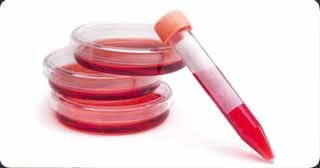Storing Cord Blood
The baby’s life inside the uterus is connected to the placenta through the umbilical cord. Placenta is the organ which provides the transaction of nutrition and oxygen between the mother and the baby. This organ completes its function right after birth and is discharged from the uterus.
After birth, the blood left between the placenta and the cord is called “cord blood”. The special characteristic of this blood is that it is different from the blood in the baby’s veins and it contains stem cells which are used in blood production. Stem cell resources, other than that of the cord blood, to be used for stem cell transplantation include bone marrow and peripheral blood (in our arms).
The most important feature of stem cells is their ability to turn into any tissue or organ when right conditions are provided. The aim of storing cord blood is that it provides an option for the treatment of probable severe diseases during a child’s growth. Another, maybe a more important reason is that in the future cord blood banks are thought to be founded and with the consent of the stem cell owners, blood stored there will be used for people in need according to their tissue type.
What is the importance of cord blood?
Basically, in human blood, there are three main types of cells within the fluid called “plasma”. These are red blood cells “erythrocytes”, white blood cells (leukocytes) and blood clotting agents (thrombocytes/platelets).
Mainly, erythrocytes function in transporting oxygen and carbon dioxide between cells, leukocytes work in order the immune system can functions and thrombocytes/platelets take part in clotting the blood with other clotting agents.
All of these cells form through the differentiation of a type of cell which can be found in the bone marrow and which is called a stem cell. That is, stem cells in the bone marrow have the ability to produce any type of blood cell and this production continues all the time.
In the case that children experience leukemia (blood cancer) or some other blood and immune system diseases, the bone marrow cannot function properly.
On the other hand, chemotherapy or radiotherapy which are used for the treatment of such diseases damage stem cells in the bone marrow. Depending on the type of the disease and treatment, sometimes, bone marrow transplant becomes the only solution. In such a case, matching healthy bone marrow and stem cells of a donor are transplanted to the patient with the aim of healthy blood cell production. The chances of finding a matching donor even among family and relatives are about 25%.
What are the types of stem cell transplant?
Previously, the term “bone marrow transplant” was used instead of stem cell transplant. Today, the main name of the procedure is “stem cell transplant” and bone marrow is only one of the resources of obtaining stem cells.
There are three types of stem cell transplant:
- Allogeneic stem cell transplant: Stem cells that are collected can be used by another person.
- Autologous stem cell transplant: Stem cells collected when the patient was in good health can be used for herself in the future.
- Syngeneic stem cell transplant: A patient can receive stem cells from his/her twin (one-cell twins)
What are the benefits of storing cord blood?
The aim of storing cord blood in cord blood banks is to create the opportunity for the baby to use his/her own stem cells to receive treatment regarding bone marrow transplant in case he/she has such a disease without the need to search for a matching donor. Thus, there won’t be any need for bone marrow transplant. Besides, there won’t be any issues regarding tissue match.
Since 1994 of all the cord blood stored in cord blood banks all around the world, only two of an estimated 160.000 of autologous cord blood have been used for autologous transplant. One of these transplants was unsuccessful due to a stem cell transplant complication which is the latent start of functioning of stem cells on the patient, and thus, the patient couldn’t be saved due to infection. The procedure on the other patient was successful.
The reason for such low rates of autologous stem cell transplant is because the chances of the baby to have a genetic disease which may require the use of his/her cord blood during treatment is approximately one in a thousand.
Another, maybe the most important aim in storing cord blood is to found “cord blood banks” in various locations, so that they can be used for others if there is a match and if the owners give their consent (allogeneic stem cell transplant).
Maybe after some time, it is probable that bone marrow transplant centres will be replaced by cord blood banks.
For how long can cord blood be stored?
Since body weight increases, body mass/capacity also increases; thus, the number of stem cells in the cord blood becomes insufficient during treatment. Therefore, the duration for cord blood storage is limited to 15 years maximum according to recent scientific data and again because of that it can be used only for the treatment of patients who are in their childhood or early puberty. When people are over 30-40 kg, this blood will, again, be insufficient.
How is cord blood retrieved?
First of all, when the decision is made to store umbilical cord blood, the related laboratory and the doctor to be in charge of the birth should be informed about it a few weeks prior to birth and necessary preparations should be arranged. That way, the required equipment and documents can be made ready for the time of birth.
During the procedure the umbilical cord is tied and the blood inside is collected in a bag via a special method in ten minutes.
Collected blood, 40-100 ml, is sent to a laboratory in the next 36 hours and there stem cells inside the blood are separated through special methods and kept frozen in nitrogen tanks (-193 degrees). This procedure can be applied in both natural/vaginal and C-section births. It is a short, easy and risk free procedure for both the mother and the baby.
Frozen cells can be used later on if required.
Who can benefit from cord blood?
There are two different views regarding this new application. Some scientists and the American Pediatric Association suggest that the application be used only on babies whose parents have a family history of diseases which might have required bone marrow transplant.
Some scientists, however, suggest the use of this alternative by everyone, considering the fast improvements in stem cell research. The possibility that these might be used for a variety of purposes in a laboratory environment in the future also supports this approach.
Some of the diseases that can be cured using umbilical cord blood, today, are:
- Childhood leukemia and lymphoma
- Thalassemia (Mediterranean anemia) ***
- Aplastic anemia (no cell production in bone marrow)
- Sickle cell anemia
- Amegakaryocytic thrombocytopenia
- Neuroblastoma
(*** Because thalassemia is an illness by birth, babies’ born with thalassemia cord blood cannot be transplanted and used for them. Treatment can be provided only through allogeneic stem cell transplant, that is, stem cells taken from a healthy person can only be used for the treatment of a child with thalassemia. Such stem cells can be retrieved from a healthy born baby’s umbilical cord blood or blood marrow.
Although some commercial blood banks advertise in their brochures, there are no applications where cord blood can be used for the treatment of hereditary illnesses such as thalassemia=Mediterranean anemia, hereditary immune failure syndromes or hereditary metabolism diseases. This is because the cord blood of a child who is with a hereditary disease cannot be used for the treatment of that disease.
The most common area where stored umbilical cord blood can be used during childhood is childhood leukemia (blood cancer) and aplastic anemia. Most cases of leukemia whose frequency is 5/1000000 can be treated only by chemotherapy.
Moreover, if a child whose cord blood has been stored needs stem cell transplant due to leukemia, the first alternative, in terms of chances of success, would be allogeneic stem cell transplant of a sibling or another donor’s stem cells with a matching tissue. (Ref: Turkish Society of Hematology)
With respect to all these reasons, it should be noted that the umbilical cord blood to be stored is not a life insurance for the baby but a probable alternative in some very special cases and that families shouldn’t see it as a “must” and push their budget to the limit.
What might happen in the future?
In the future, stem cells may be used to produce spare parts, just like for cars; liver, heart, pancreas, brain, hands, arms and legs may be produced and organ loss treatments due to accidents and diabetes, liver or kidney failure, neurologic losses (paralysis), Parkinson’s, Alzheimer’s and many genetic and cancer treatment methods may change in this direction.
In the future, we, as doctors, will try to cure the patient instead of trying to cure the disease. We are at the initial stages of such improvements which will require a long time.


